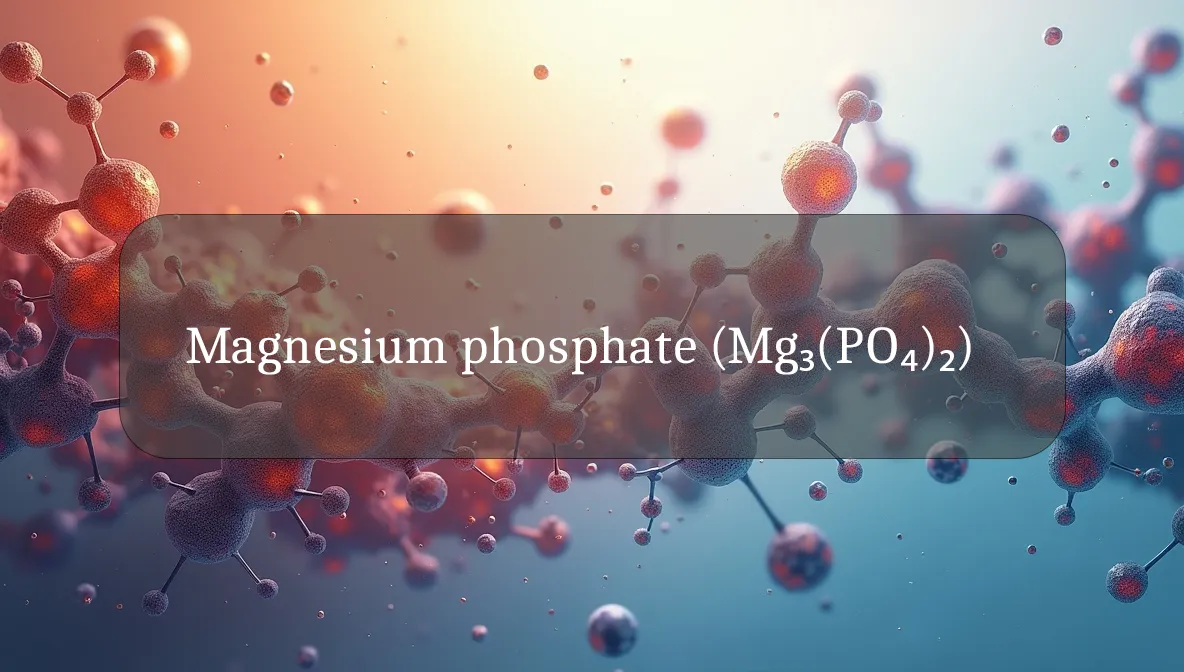Mineral Duo for Energy and Strength
Magnesium phosphate, a lesser-known but vital mineral compound, plays a key role in keeping your body energized and your bones strong. This guide dives into what magnesium phosphate is, how it supports your health, and practical ways to ensure you’re getting enough to feel your best.
Chemical Identity and Composition
Magnesium phosphate, with the chemical formula Mg₃(PO₄)₂, is a compound made of three magnesium ions and two phosphate ions. It’s a naturally occurring mineral in your body, found in bones, teeth, and cells, where it helps with energy production and structural support. Think of it as a dynamic duo—magnesium brings the calm and energy, while phosphate builds the framework for your bones.
Biological Role and Health Benefits
Magnesium phosphate is a powerhouse for your wellness:
- Energy Production: Magnesium is crucial for creating ATP, your body’s energy currency, while phosphate is a key part of ATP’s structure. Together, they fuel every cell in your body.
- Bone Health: About 60% of your body’s magnesium and 80% of phosphate are stored in bones, where they team up to maintain strength and density.
- Muscle Function: Magnesium helps muscles relax after contraction, preventing cramps and supporting smooth movement.
- Nerve Health: Magnesium stabilizes nerve signals, promoting calm and focus, while phosphate supports cellular communication.
- Enzyme Support: Both minerals activate enzymes that drive metabolism, digestion, and DNA repair.
By supporting these processes, magnesium phosphate keeps you energized, mobile, and resilient.
Sources (Dietary/Supplemental)
Your body doesn’t make magnesium or phosphate, so you need to get them from food or supplements:
- Dietary Sources:
- Magnesium-rich foods: Nuts (almonds, cashews), seeds (pumpkin, sunflower), leafy greens (spinach, kale), whole grains (quinoa, oats), and dark chocolate.
- Phosphate-rich foods: Fish (salmon, tuna), poultry, eggs, dairy (milk, yogurt), beans, and whole grains.
- Combo-rich foods: Dairy, nuts, and seeds often provide both magnesium and phosphate in one package.
- Supplemental Sources:
- Magnesium supplements (e.g., magnesium citrate, oxide, or phosphate) for those with low intake or specific needs.
- Phosphate supplements are rare since most diets provide enough, but they’re sometimes used in medical settings for deficiencies.
- Multivitamins or bone health formulas may include magnesium phosphate for balanced support.
A varied diet rich in whole foods typically supplies enough of both minerals for most people.
Imbalance Signs
Imbalances in magnesium or phosphate can disrupt your health:
- Deficiency Signs:
- Magnesium: Muscle cramps, fatigue, irritability, irregular heartbeat, or poor sleep.
- Phosphate: Weak bones, joint pain, fatigue, or loss of appetite (rare in healthy diets).
- Combined: Weakness, bone pain, or low energy, as both are critical for bone and cell function.
- Excess Signs:
- Magnesium: Diarrhea, nausea, or low blood pressure (usually from over-supplementation).
- Phosphate: Kidney issues, calcium imbalance, or soft tissue calcification (often from excessive processed food additives or supplements).
- Combined: Rare, but high levels of both can disrupt calcium balance, affecting bones and kidneys.
If you experience these symptoms, a healthcare provider can test your levels and guide you.
Supporting Optimal Levels
To keep your magnesium phosphate levels balanced for vibrant health:
- Eat Whole Foods: Prioritize magnesium- and phosphate-rich foods like nuts, seeds, fish, and greens. Limit processed foods high in phosphate additives (e.g., sodas, fast food).
- Pair with Vitamin D: This vitamin helps absorb both magnesium and phosphate. Get it from sunlight, fatty fish, or fortified foods.
- Stay Active: Exercise, especially weight-bearing activities like walking or yoga, supports bone health and mineral use.
- Hydrate Well: Proper hydration helps your kidneys regulate magnesium and phosphate levels.
- Supplement Smartly: If you’re low on magnesium (common in stressful lifestyles), choose a bioavailable form like magnesium citrate. Avoid overdoing supplements, as excess can harm kidneys.
Simple habits like these ensure your body has the magnesium and phosphate it needs to thrive.
Safety, Interactions, and Precautions
Magnesium phosphate is generally safe when consumed through food, but supplements require caution:
- Safety: Most people get enough phosphate from diet, and magnesium deficiency is more common than excess. Over-supplementing either can upset mineral balance.
- Interactions:
- Magnesium supplements may reduce absorption of antibiotics (e.g., tetracycline) or bisphosphonates (for osteoporosis). Take them 2–3 hours apart.
- High phosphate intake (from processed foods) can lower calcium absorption, weakening bones.
- Diuretics or kidney medications may affect magnesium and phosphate levels.
- Precautions:
- If you have kidney disease, avoid magnesium or phosphate supplements without medical advice, as your body may struggle to clear excess.
- People with heart conditions or on magnesium-based antacids should monitor intake to avoid overload.
- Choose reputable supplement brands to avoid contaminants or low-quality forms.
Fun Fact
Did you know magnesium phosphate is used in some eco-friendly fertilizers? Its natural ability to release magnesium and phosphate slowly helps plants grow strong, just like it supports your bones and energy!
Citations
- National Institutes of Health, Office of Dietary Supplements. (2025). Magnesium Fact Sheet for Health Professionals.
- Mayo Clinic. (2024). Bone Health and Mineral Balance.
- Cleveland Clinic. (2023). Magnesium: Why It’s Important for Your Health.
- World Health Organization. (2022). Nutrition: Minerals for Health.
- USDA FoodData Central. (2025). Nutrient Database for Magnesium and Phosphorus.

